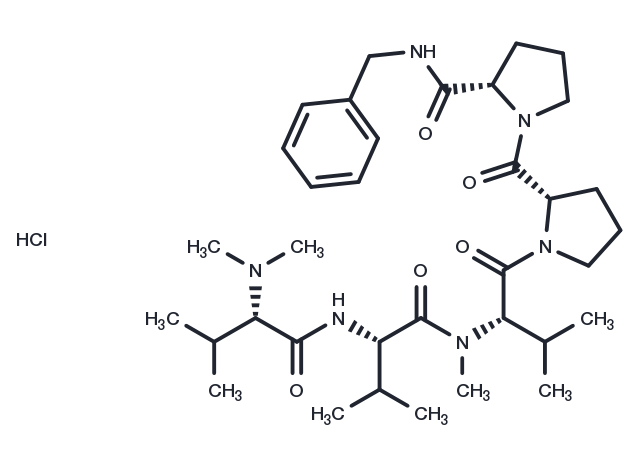Powder: -20°C for 3 years | In solvent: -80°C for 1 year


Cemadotin hydrochloride is the salt from of Cemadotin (free base), also known as, LU103793, a mitosis inhibitor potentially for the treatment of solid tumours. Cemadotin is also a synthetic derivative of Dolastatin 15, an antiproliferative compound which was isolated from the mollusk Dolabella auricularia. Like Dolastatin 15, LU103793 is highly cytotoxic in vitro (IC50 = 0.1 nM). LU103793 inhibits microtubule polymerization in a concentration-dependent manner (IC50 = 7 microM). Treatment with this compound also induced depolymerization of preassembled microtubules. Cell cycle analysis of tumor cell lines treated with LU103793 indicated a block in the G2-M phase.

| Pack Size | Availability | Price/USD | Quantity |
|---|---|---|---|
| 25 mg | 6-8 weeks | $ 1,520.00 | |
| 50 mg | 6-8 weeks | $ 1,980.00 | |
| 100 mg | 6-8 weeks | $ 2,500.00 |
| Description | Cemadotin hydrochloride is the salt from of Cemadotin (free base), also known as, LU103793, a mitosis inhibitor potentially for the treatment of solid tumours. Cemadotin is also a synthetic derivative of Dolastatin 15, an antiproliferative compound which was isolated from the mollusk Dolabella auricularia. Like Dolastatin 15, LU103793 is highly cytotoxic in vitro (IC50 = 0.1 nM). LU103793 inhibits microtubule polymerization in a concentration-dependent manner (IC50 = 7 microM). Treatment with this compound also induced depolymerization of preassembled microtubules. Cell cycle analysis of tumor cell lines treated with LU103793 indicated a block in the G2-M phase. |
| Molecular Weight | 677.33 |
| Formula | C35H57ClN6O5 |
| CAS No. | 172837-41-1 |
Powder: -20°C for 3 years | In solvent: -80°C for 1 year
You can also refer to dose conversion for different animals. More
bottom
Please see Inhibitor Handling Instructions for more frequently ask questions. Topics include: how to prepare stock solutions, how to store products, and cautions on cell-based assays & animal experiments, etc.
Cemadotin hydrochloride 172837-41-1 inhibitor inhibit
